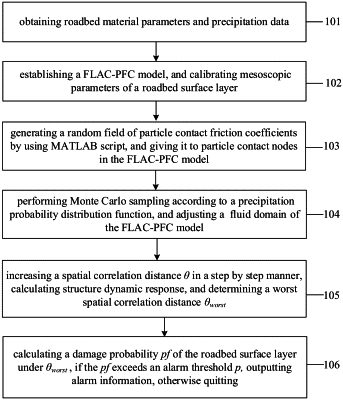| CPC G01V 99/005 (2013.01) [B61L 23/04 (2013.01); G06F 30/25 (2020.01); E01B 1/002 (2013.01)] | 7 Claims |

|
1. A ballastless track roadbed damage forewarning method, comprising the following steps:
step 1: obtaining roadbed material parameters and precipitation over a period of time;
step 2: establishing a fast Lagrangian analysis of continuum (FLAC)-particle flow code (PFC) model of a ballastless track roadbed, calibrating particle materials of a roadbed surface layer according to the roadbed material parameters obtained in step 1, and obtaining mesoscopic parameters of the particle materials; wherein FLAC is a kind of continuous medium mechanics analysis software, which is used to establish a finite difference model of a base plate and a roadbed bottom layer; PFC is a particle flow program built in FLAC, which is used to establish a discrete element model of the roadbed surface layer; and the FLAC-PFC model is to call PFC program through a built-in interface of FLAC, so as to perform a coupling analysis between the finite difference model of the base plate and the roadbed bottom layer established by FLAC and the discrete element model of the roadbed surface layer established by PFC;
step 3: generating a lognormal random field of particle contact friction coefficients, and assigning the lognormal random field to particle contact nodes of the roadbed surface layer in the FLAC-PFC model obtained in step 2;
step 4: performing Monte Carlo sampling based on a probability density function of the precipitation over the period of time obtained in step 1, and adjusting a fluid domain of the roadbed surface layer according to the precipitation;
step 5: increasing a spatial correlation distance θ in a step by step manner, calculating a dynamic response of the base plate, and determining a worst spatial correlation distance θworst; and
step 6: calculating a damage probability pf of the roadbed surface layer under the worst spatial correlation distance θworst obtained in step 5; outputting alarm information to monitoring personnel when the damage probability pf exceeds an alarm threshold p, thereby maintaining, by the monitoring personnel, the ballastless track roadbed in response to the alarm information; otherwise, quitting.
|